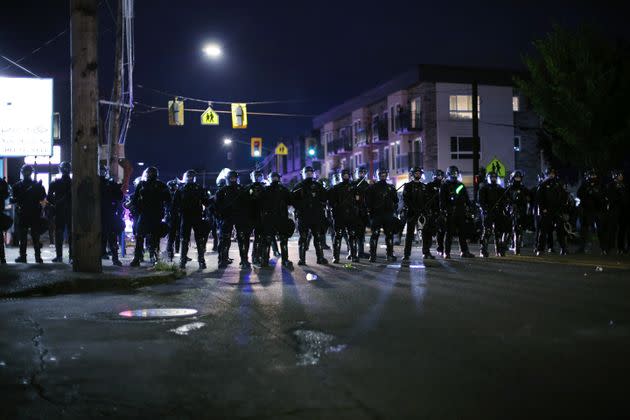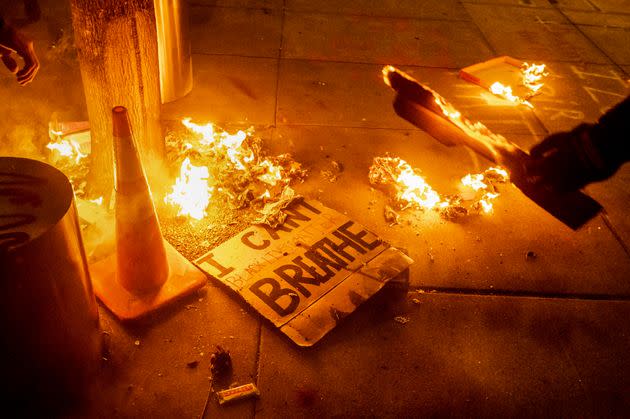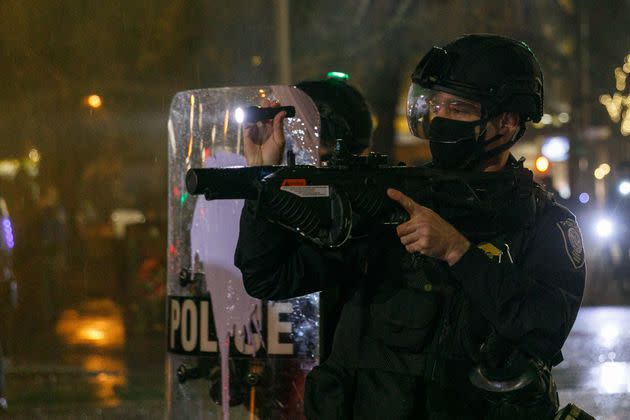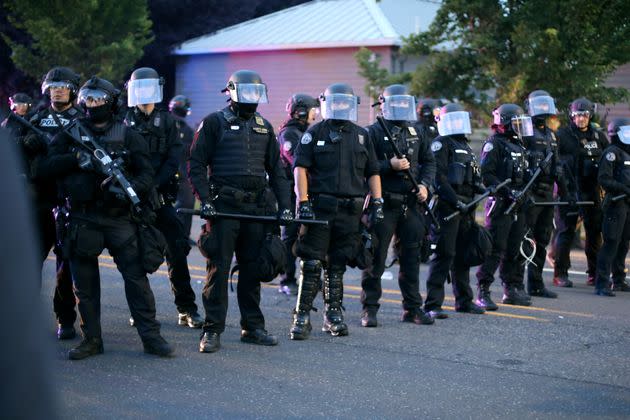Why A Victim Of Police Brutality Chose Restorative Justice For The Cop

A line of Portland police officers stands with batons in hand during a protest at the Portland Police Association's union building on June 30, 2020.
A Portland, Oregon, police officer issued a public video apology to a woman he assaulted with a baton during a protest amid the racial reckoning that arose during the summer of 2020.
Teri Jacobs, a photojournalist, was working at a protest that went awry in Portland on Aug. 18, 2020. When police ordered that the crowd disperse, Jacobs, who identified herself as a member of the press, said she was trying to help a friend when an officer named Corey Budworth began to hit her repeatedly with a baton on the head, neck and back. Jacobs said she went to the hospital the next day with bruises on her face and bumps on her head.
A month later, Jacobs sued the city of Portland and was subsequently awarded $50,000 to settle the case.
Budworth, who joined the Portland Police Bureau in 2016, was indicted on a fourth-degree assault charge on June 15, 2021.
The police union put out a statement that day calling Budworth’s indictment a “politically driven charging decision,” painting Jacobs as someone engaged in “unlawful activities” and Budworth as a “committed public servant of the highest integrity.” In solidarity with Budworth, the entire Rapid Response Team, which responded to protests, resigned from the unit.
Two years later, Jacobs and Budworth came to a new agreement: They would each participate in a restorative justice program managed by the Multnomah County District Attorney’s Office.
Restorative justice works as a stark alternative to the default U.S. criminal justice system, which regards being punitive as justice. Restorative justice seeks to involve both the victim and the person who caused harm in a rehabilitation process.
In this case, Jacobs had a series of conversations with independent facilitators to prepare her to engage in conversation with Budworth. This week, the officer issued a public video apology to Jacobs in exchange for his misdemeanor charge being dropped.
This is a video you won’t often see. A public apology from a Portland Police Bureau Officer for beating our client Teri Jacobs at a protest in August 2020. This video came out of a restorative justice process that Ms. Jacobs and Officer Corey Budworth have participated in. pic.twitter.com/9Zf0NUfO4Q
— Oregon Justice Resource Center (@OJRCenter) July 11, 2023
“I acknowledge the physical and emotional harm my actions caused, and I am committed to ensure that I do not cause that kind of harm moving forward,” Budworth said in the video. “During my reflection of the evening, the force used against Ms. Jacobs could have been avoided, and I’m sorry, Ms. Jacobs.”
He added: “I understand the harm that was caused was not limited to Ms. Jacobs and was felt by others in the community when there was a great distrust of law enforcement,” he said.
The response on social media was mixed. Some criticized the video of Budworth’s apology, arguing that he had this opportunity only because he’s a police officer instead of a civilian. Others said his apology seemed scripted and therefore inauthentic.
The charge against Budworth was dropped last week, according to KGW-TV in Portland.
HuffPost spoke to Teri Jacobs about the apology video, restorative justice and the altercation that started the chain of events.
(This interview has been altered for clarity and brevity.)
Can you talk to me a bit about your experience the day Officer Budworth assaulted you and what the process moving forward has been like for you?
As you know, I was not part of the protest, but I was photographing the protest. And, well, it was really the experience of getting knocked around and hit in the head multiple times, pushed down, that was really scary.
I just remember after he knocked me to the ground and I was kind of flying headfirst down into the pavement, I had on a full-face gas mask respirator, but my nose pressed up against the respirator as it was on the concrete. So my face was pretty much pressed up against the ground. And that was extremely scary. All I could think of was George Floyd being face down on the ground. And I knew that I needed to get myself off the ground as quickly as possible because that is the worst position you could possibly be in — especially when it’s a police officer who’s doing this to you.
I’m a very small person in stature. I’m 5 foot 2 inches and 110 pounds. So having all these large people above me, I really didn’t really know what was happening.
When I got home, I looked like I had just been in a fight or something. My face was all bruised and puffy.

A Black Lives Matter protester burns a sign outside the Mark O. Hatfield U.S. Courthouse on July 21, 2020, in Portland, Oregon. Protests spread across the country after the police killing of George Floyd in Minneapolis on May 25, 2020.
And what was the emotional healing process after that?
I was very angry about it. Never been in a fight, I’m a rule follower, but obviously I do the right thing and I stand up for what’s right, and I was trying to help my friend in that moment.
And so I just had a lot, I already had anger towards the cops, and this just exacerbated it tenfold, and it kind of lit a fire underneath me.
Are you satisfied with the officer’s response? If so, would you recommend that other instances be resolved this way? If not, is there anything you wish could have been done here or suggestions for future instances?
It was pretty frustrating. And it was a long process. There were two facilitators that I met with, and we talked about what I wanted to convey, what I wanted to hear from Budworth or what I was willing to hear. But then that doesn’t really prepare you for actually meeting this person that attacked you on the streets.
I had the mindset that was he was going to really hear what I was saying and he was going to feel really awful and he would really understand my point of view. And that wasn’t really the case.
He listened to me, but he is a police officer, and it was hard for him to understand where I was coming from. For everyone who was protesting, everyone that’s been attacked by the police, I hoped that he would apologize for the whole police force. But he didn’t really see it that way.
I guess I just have a lot of anger towards not just him, but all the police.
So we met over Zoom and spoke. The second time we met was not the greatest.
After I spoke to him, I realized that he wasn’t going to really see my side, or he wasn’t ever going to be able to understand where I was coming from. Then I kind of decided that I didn’t really want to talk to him anymore one-on-one and I just wanted a public apology to be the end of it. And that was something he was willing to do.
The restorative justice process really enables the victim to set the pace and basically decide what I need in order to feel like justice is served. It was really up to me, within reason, but I got to decide what was important to me.
I think that this model can be used as a way to keep people out of prison. And I hope that it is used and that people are willing to trust this process. But if he was not willing to do that [a public video apology], then the charges would’ve been reinstated and we would’ve gone to trial and then the traditional process would have been kicked back into gear.
The hope is that the perpetrator is going to grow and learn from that conversation with the person that they harmed and make changes.
Budworth was charged with fourth-degree assault after that day, leading to the resignation of the entire 50-member Rapid Response Team. You were awarded a $50,000 settlement from the city of Portland. And recently his charge has been dropped following the restorative justice process. In watching everything play out, is this what you would have expected to follow? How do you feel about the chain of events?
When this incident happened to me, I sent a public letter to the mayor asking him to condemn Officer Budworth since he was so adamant about condemning all of the violent criminals that are on the streets. And he never responded or would not publicly say anything.
And then the president of the PPA [Portland Police Association] at the time made a statement after Budworth was charged and the Rapid Response Team all quit, calling Budworth an excellent police officer and “Teri Jacobs is a criminal.”
Now that Budworth had admitted that he was wrong, I expected to hear a response from the mayor and from the police union going back on the things they said.
And then it took some time to do this restorative justice process, but I felt like this process could have more meaning. I don’t think he was going to ever face prison time, but he would’ve had a misdemeanor charge attached to his name. But hopefully, with this process, he at least got to hear my perspective on how his actions affected me. And he has the opportunity to grow and change from that rather than, say, if he was sent to prison for, even if it was just for a couple of days, I’m sure there would be no growth. I mean, people get more angry and more violent when they’re in prison.

A Portland police officer uses tear gas as people gather to protest police brutality near the federal courthouse on Dec. 31, 2020.
What are your thoughts on the apology video itself? Do you feel like it accurately reflected your conversations with Officer Budworth and what you each got out of the process?
I was actually very happily surprised with his tone and with the words that he chose to say because during our conversations he was a lot more defensive. And I didn’t quite feel like he truly apologized. I mean, he did say the words, but I think it was probably hard for him to just apologize and take ownership without making excuses.
So, yeah, I’m happy with the video. I feel like it was probably not easy for him to make that video.
What are your thoughts on the social media criticism that came with the video? Some users wrote that it seemed that he was only offered this form of justice because he was a cop instead of a civilian. Others said it seemed disingenuous or scripted and spoke in favor of transformative justice instead.
There were definitely many points that I needed him to say for me to feel like it was what I needed. I wrote out a list of the things that I needed from him, because I think that if he didn’t mention the things that he did, then I would not have felt good about it. And if I did not feel good about it, then the process would not have been complete and his charges would not have been dropped. So obviously it was scripted.
And he is a cop, and I think if he did have the charge against him, he would still be able to be a cop. He wouldn’t lose the job for having a misdemeanor. And I don’t think he wouldn’t have done prison time or jail time or anything.
I thought that because it was such a public case, people could see this public case being played out with a police officer. And maybe because they said it was good enough for a cop, maybe they would be more willing to agree to have this same process with someone else.
As Budworth brought up in his apology video, your story is intertwined with the movement calling for police abolition, defunding the police and protecting Black lives and the numerous 2020 protests. How does restorative justice fit into the abolition or defunding of police and bringing community healing?
Well, if we want to get rid of prisons, then we need other forms of justice. And people do harm, so this is a model I hope will be used to keep people out of prison and to give people the opportunity to make it right.
People make mistakes. When someone gets incarcerated, it can ruin your life completely. And a lot of people don’t have the opportunities or the means to restore your life after something like that. This process could help prevent people’s lives from being taken and put into the criminal justice system and forgotten about.

Portland police officers stand in a line holding their batons and guns on North Lombard Avenue during a protest at the police union building on on June 30, 2020.
Was there anything that surprised you about going through the restorative justice experience with Budworth?
I didn’t really know what to expect. I just knew that it was a different modality for justice that could help people in the future, and that could have a positive impact on the community. And so I was willing to give it a try because it was such a public case.
I was also hoping to be able to have Budworth actually make changes within the policing and make policy changes — I quickly learned that was really not possible considering he’s just a cop and he’s got bosses and a police chief and mayor and all that. So I guess that was a little disappointing.
In what ways do you think your experience with restorative justice at this center should be applied to other instances where justice is sought, whether it’s in the restorative justice world or not?
I hope that it’s applied to any case that it can be. For me, it was a video apology, but for somebody else, it might be, say, someone had a store broken into. It might be that person coming in and helping in the store and helping clean it up or spending 20 hours volunteering in the store to make back whatever money was lost or something. It could really be anything, I think. So I would hope that rather than sending people to prison to disappear for years on end, it can be used to actually help people to make right whatever was wrong and grow and be better people afterward.
What effect would you like your experience and the video of Officer Budworth’s apology to have on people?
It’s rare to see a police officer admit to doing something wrong. Even when someone like Patrick Kimmons, who was running away from police, was shot nine times and murdered.
I think that is difficult for the police because they can make up whatever they want.
I did this with this white police officer because of the impact that restorative justice could have for the most marginalized people, the people that are incarcerated and the huge number of Black and brown people that are put into the system for minor charges.
I did this process hoping that, though it might not be so easy to hire a lawyer or to get out of the charge brought against you, doing restorative justice could prevent people from being a part of the system — especially Black and brown young men.
CORRECTIONS: A previous version of this article included an inaccurate settlement amount. Also, the story has been updated to reflect that the Multnomah County District Attorney’s Office, not the Oregon Justice Resource Center, managed the restorative justice process.
